This is a Veteran Owned site
![]()
 |
The Lumber Wizard III is easy to use, locates virtually any type of metal and is very accurate. If you want to preserve your cutting tools, you need this metal detector! Click image to enlarge |
Lumber Wizard III
Preventing chips, nicks – and danger
Text, photos and video by Tom Hintz
Posted – 5-13-2007
We all spend a lot of money on quality cutting tools such as table saw blades, router bits and jointer and planer knives. While most of us try to extend their lives with moderate-depth cuts and feed rates, too few take the additional - and most important – step of searching for hidden bits of metal before making the cuts.
Surprisingly small bits of metal can nick jointer or planer knives instantly and even fracture a carbide cutting edge of a router bit or table saw blade. Encountering a piece of metal has been known to knock a tooth off of an otherwise perfect table saw blade. Because our cutters are always turning towards the operator, any of these scenarios can be a safety issue.
Electronics to the Rescue
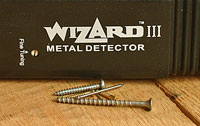 |
I was able to find every type of fastener, regardless of the metal it was made of, with the Lumber Wizard III. Click image to enlarge |
Visually inspecting wood before cutting is a good but unreliable first step. Seeing the end of a broken off brad or finish nail even if it is at the surface is difficult to impossible on a good day. Finding bits of metal below the surface of that may be “grown into” the wood – something that happens more frequently than many of us suspect – has been virtually impossible until recently.
The combination of emerging technology and the times we live in spurred the electronics industry to develop reliable, hand-held metal detectors. It didn’t take long for this security-based technology to find its way to woodworking, offering a simple, easy to use solution for the very difficult task of finding hidden metal in the material we use before the cutters do.
Features
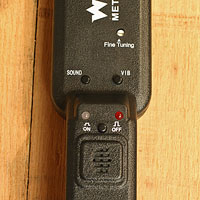 |
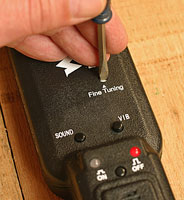 |
All controls (top) are easily reached and self explanatory. You can use either the beep or vibrating warning - or both simultaneously. (bottom) The only adjusting necessary is fine-tuning the sensitivity. Click images to enlarge |
The Lumber Wizard III, from Wizard Industries has quickly become a favorite of woodworkers because it works very well and is extremely accurate. At 18”-long and weighing only 13-ounces, the Lumber Wizard III is easy to use in the smallest of shops because it goes to the wood. That portability also allows checking and sorting wood before it enters the shop or to check individual pieces before machining. The metal detecting coil is housed in a 7”-long section at the end of the Lumber Wizard III. That makes it easy to check the wide faces of the most common stock widths we use in one pass.
The Lumber Wizard III has an On/Off button on the handle as well as buttons controlling the audible beep warning and the vibration mode. Both can be used individually or together. A small speaker is also mounted at the base of the handle.
A fine tuning screw is located just ahead of the buttons and allows the user to tweak the sensitivity of the Lumber Wizard III as needed for the job. This fine tuning capability is important because the Lumber Wizard III is very powerful. Controlling its sensitivity makes it much easier to use in a wider range of circumstances.
The Lumber Wizard III is capable of detecting virtually all types of metal, including aluminum, brass, bronze, lead, magnesium, steel, stainless steel and zinc. In my testing I could not find a type of metal the Lumber Wizard III did not detect nor a metal that caused it to be less sensitive.
In the Shop
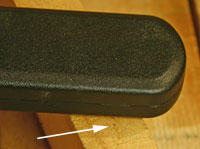 |
I was able to locate a single leg from a staple that was buried in this oak. I put it there for this evaluation but had difficulty seeing it the next day. The Lumber Wizard found it every time. Click image to enlarge |
After installing the single 9V battery, I followed the simple setup instructions that involve turning it on and adjusting the sensitivity. That’s all it needs to be readied for use.
I went through the shop and quickly located small bits of metal I already knew existed just to see if the Lumber Wizard III was working and to get a feel for how is used. What surprised me was how accurate and fast the Lumber Wizard III is. There is no delay or guesswork when it encounters metal. The beep warning (or vibration mode if desired) notifies you immediately when the wand is over even surprisingly small pieces of metal.
I tried to fake the Lumber Wizard III out but other than hiding small pieces of metal on the other side of more than an inch of solid wood, it sensed everything I tried including small brass and aluminum fasteners.
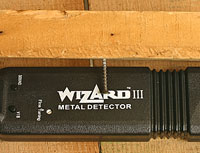 |
The Lumber Wizard was able to see/find the fine point of this screw through just over 1" of solid oak! And, scanned from the opposite side, it did it every time. Click image to enlarge |
A single leg of a small staple was driven into the edge of a heavy piece of oak. Though difficult to see, the Lumber Wizard III picked it out easily. I tried driving common wood screws into the same wood and the Lumber Wizard III often picked them out an inch or two before it was actually over them
To test the depth at which the Lumber Wizard III scans wood I ran a thin, pointed drywall screw into the bottom of a 1 ¾”-thick piece of oak and scanned it from the opposite side. I slowly increased the depth of the screw until the Lumber Wizard III found it, then measured the amount of the screw that was embedded in the wood. The Lumber Wizard III accurately (and repeatedly) located the fine point of the drywall screw while it was just over 1” below the surface being scanned. That means if both sides of a piece of wood are scanned with the Lumber Wizard III, you can use 2”-thick material with confidence.
Video Tour! |
Throughout the evaluation, I could not find a type of metal that could escape detection by the Lumber Wizard III. Even partial staples, fully buried in the wood, were found every time. The only logical conclusion is that the Lumber Wizard III works at least as good as claimed. By my testing, I think it works even better.
The only way to confuse the Lumber Wizard III is to try scanning wood that is resting on metal itself. Trying to scan wood that is lying on a cast iron tabletop for instance will frequently elicit false “hits”. That large mass of cast iron can itself set off the Lumber Wizard III while it is several inches away.
Conclusions
The Lumber Wizard III is a must-have piece of equipment for all of us that lack an endless blade or cutter budget. You may have escaped metal-related damage so far but the odds are stacking against you. I have personally found bullets, broken screws, nails and many of those aggravating staples retailers seem to spray across the wood
With a street price of $99.99 (5-12-2007) the Lumber Wizard III is
Pricing Link |
Click the image above to see the Lumber Wizard on the Woodcraft website |
a bargain if it prevents one damaged blade or knife. Consider the time and effort required to buy and replace a cutter along with the peace of mind this unit provides and the Lumber Wizard III is an outright bargain. I will never again put a piece of wood onto a machine without first giving it a quick scan for metal with the Lumber Wizard III.
Visit the Wizard Detectors web site - Click Here
Have a comment on this review? - Email Me!
All written, photographic and drawn materials are property of and copyright by NewWoodworker.com LLC 2000-2019. Materials may not be used in any way without the written permission of the owner.
